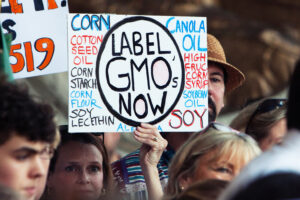
Walking into a grocery store, a consumer can learn just about any nutritional fact her heart desires– from percent daily iron levels to relative content of monocalcium phosphate–with the flip of a package. And yet, it is nearly impossible to discern exactly which foods contain genetically modified components. The Institute for Responsible Technology defines genetic modification as “a laboratory process where genes from the DNA of one species are extracted and artificially forced into the genes of an unrelated plant or animal.” The resulting genetically modified organisms (GMOs) are becoming increasingly prevalent–in fact, according to the Grocery Manufacturers Association, 70-80 percent of conventional processed foods in the United States contain genetically modified components. To the dismay of a growing number of consumers, they are becoming increasingly infused (and hidden) in everyday food products. Aside from a tiny portion of brands whose labels boast “GMO-Free!” American consumers have no definite way of avoiding these products, if they desire to do so.
And many American consumers do. In fact, a significant majority of Americans repeatedly poll in favor of GMO-labeling regulations. In Washington, the GMO labeling debate is heating up with a new proposition on the general elections ballot, taking place November 5. The initiative, dubbed I-522, calls for any food that is genetically modified or contains genetically modified products to be clearly labeled as such. Although this may seem to be a minor demand, I-522 and other bills like it face serious opposition from the largest GMO producers–biotech giants like Monsanto and DuPont. These companies engineer products that can withstand high levels of pesticides. Conveniently enough, they also happen to produce and sell these pesticides. In fact, the complete absence of labeling laws and regulations in the U.S. today is a direct result of these companies’ counter-attacks. Last year, a California bill known as Proposition 37, which essentially proposed the same regulations as Washington’s I-522, was voted down in a narrow margin that didn’t reflect the disparity in financial backing between the bill’s proponents and opponents.
Last year, a California bill known as Proposition 37, which essentially proposed the same regulations as Washington’s I-522, was voted down in a narrow margin that didn’t reflect the disparity in financial backing between the bill’s proponents and opponents. According to Nathanael Johnson of grist.org, an environmental news website, supporters of this bill were financially outmatched by opponents who outspent them five to one with $42 million in the six weeks before the vote. Ultimately, GMO supporters only managed to shoot down the bill by 3 percent.
Monsanto claims that labeling initiatives are superfluous due to a lack of condemning results and inconclusive findings regarding the safety of GMO products. Its website insists that “mandatory labeling could imply that food products containing these ingredients are somehow inferior to their conventional or organic counterparts.”
Biotech companies also cite the cost of labeling as a reason for their opposition to these initiatives. In combatting Proposition 37 in California, the spokeswoman for the Against the Deceptive Food Labeling Scheme, Kathy Fairbanks, asserts that mandatory GMO labeling would “force California families to pay hundreds of dollars more in higher food prices, would cost millions in government bureaucracy, and would not provide any health and safety benefits.” Yet manufacturers are constantly obligated to update and alter their packaging, which the president and founder of Nature’s Path refers to as a “regular cost of doing business, a small one at that, …already built into our cost structure.” If cost were the real issue, Monsanto and other biogiants could simply put the millions they spend on
anti-label campaigns toward the allegedly prohibitive costs of labeling.
Meanwhile, the scientific community does not support biotech companies’ claims that their products are not at all harmful or unsafe. At the very least, the debate remains open, and according to Stacy Malkan, a spokeswoman of California’s Right to Know organization, “Many scientists are saying that in the face of scientific uncertainty, labeling is an important tool to help track potential health risks.” Indeed, without proper labeling of GMOs, there is no way to measure what effects these products are having on human health, as they are being consumed in unprecedented varieties and quantities.
Given the controversy surrounding newly produced biotech foods, the vote in Washington this October will demonstrate once again whether the American public, which has polled time and again in favor of labeling GMO products, will be able to actualize that demand in law. Will Monsanto and other biotech giants have the same sway in Washington with huge donations to anti-labeling campaigns, or will voters be able to withstand the influence of these donations in an unprecedented way? There is no denying that Washington’s vote on I-522 will make an impactful statement regarding America’s opinion on genetically modified foods. This vote will show whether or not America is ready to step up to the plate to keep modified mystery foods off of it.